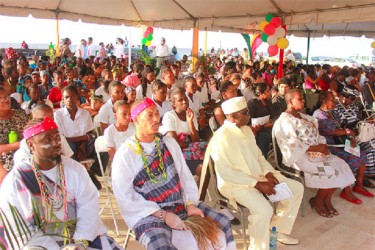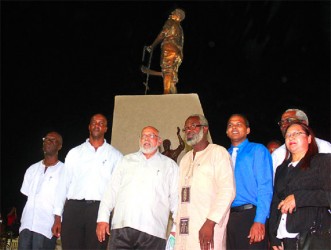Despite the controversy over its siting, government last evening unveiled the 1823 Monument and President Donald Ramotar hailed it as a sign that the nation would not forget the struggles of its ancestors.
The monument, which was designed and built by US-based Guyanese sculptor Ivor Thom, is located along the Seawall Road opposite the Guyana Defence Force’s Camp Ayanganna headquarters. Members of the opposition and the African Cultural and Development Association (ACDA), which has been protesting the siting because it has no historical connection to the 1823 slave revolt, were not in attendance at last evening’s ceremony.
Addressing the large gathering at the unveiling, including several government ministers and joggers, Ramotar said that the monument is a dedication to the heroes of the 1823 East Coast revolt. He also called the hour-long unveiling a historic one, representing both a dedication to our historical past and national recognition of the slaves who were willing to make a sacrifice to ensure freedom for themselves and their descendants. He added that people should use the experiences of their ancestors to work with others in similar circumstances to try to improve conditions for development and end the inequality that exists in the world.

A monument, he said, is a structure created to commemorate an important event as part of the remembrance of historic times. He added that the 1823 Monument is a reminder to all that we will not forget “their struggles” or the sacrifices of our ancestors.
Meanwhile, Minister of Culture Frank Anthony said that many people forget that August 17, 1823 saw the largest slave rebellion in the history of the Western Hemisphere and which helped to accelerate the abolition of slavery.
In tracing the genesis of the monument, Anthony recalled that in April 2011, a national competition was launched for the design of the monument. He said that five designs were received but Thom’s design was subsequently selected after the evaluation of a technical panel.
He said that traditionally the country’s ability to do bronze sculpture was very limited but “we are very pleased that for this project we now have the capacity at the Burrowes School of Art to do many more such monuments.” Anthony added that a site selection committee was also established and advertisements were placed several times in the newspapers for proposals on where the monument should be placed. “On all such occasions nobody responded to our request,” he said, while adding that the committee identified 10 villages on the East Coast based on the history of the uprising. He said in addition to those, five sites in Georgetown, including the Parade Ground and the Seawall, were identified. He said that the committee, after reviewing all the sites opted for the one where the moment has been built.

“Unfortunately, when work started at the current site and was very far in advance, we then received requests from some individuals that we should change the site,” he said, adding that government was unable to accommodate that “belated request.” “We regret the controversies that erupted around the siting,” he added, while pointing out that he believes it is now time for focus to be paid on the purpose for the building of the monument.
The monument is located at the centre of large plot of land with a white picket fence on three sides, while the area immediately around the monument has been transformed into a garden-like atmosphere with plants and white concrete benches.
Thom, speaking about the technical aspects of designing and building the monument, said that he studied the history of the rebellion and decided to incorporate rebellion, revolution and religion together. He included a cross to symbolise religion and chains to represent slavery. He said that he decided that it would be made up of three figures; one male figure standing erect with legs apart, another male figure to the side and a female figure to the other side.
He said that the monument was completed at the end of July last year but there was a wait for the base to be completed.
The programme yesterday began with a libation ceremony to consecrate the ground on which the monument stands. There was drumming done by members of Magic Fingers as well as several dances.

The construction sparked opposition as Afro-Guyanese groups expected the monument to be erected at Parade Ground, which was the location where some of slaves who participated in the uprising were hanged. The protesting groups, including ACDA had repeatedly held picketing exercises against the Culture Ministry mainly because former President Bharrat Jagdeo had made a commitment to erect the monument at Parade Ground during a sod turning exercise held there in 2000. Other civic-minded groups and persons have also written letters to the media in protest over the site that was selected.
In January this year, ACDA, the All African Guyanese Council, the Pan-African Movement, the African Welfare Council, the Guyana Institute of Historical Research, and the People’s Parliament announced the formation of a coalition to establish the 1823 monument in its rightful place, dubbing the ministry’s planned location disrespectful to African ancestors.
They had said that the monument is being disconnected from the site of insurrection without realistic consultation from the Guyanese society and the African groups.
The coalition has said that it will be raising funds to construct their own memorial. The government constructed the base at a cost of $26M. It is unclear how much money was spent to make the sculpture.









